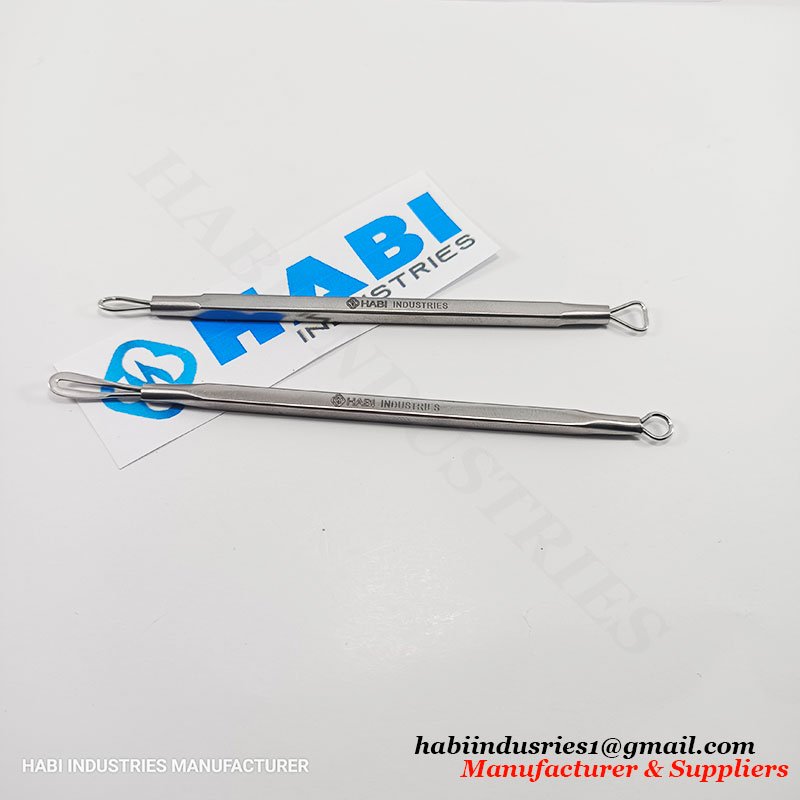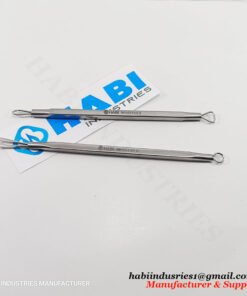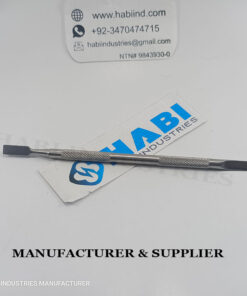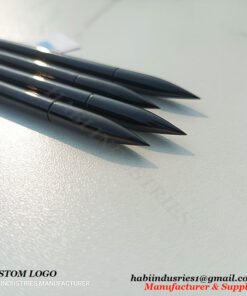Facial Acne Blackhead Tools – Manufacturer of Blackhead Blemish Extractor Set
Facial acne blackhead tools are specially designed instruments to remove blackheads, whiteheads, and other blemishes safely and effectively without causing damage to the skin. These tools are essential for maintaining clear, healthy skin as part of a professional or at-home skincare routine.
Contact us: SALES@HABIIND.COM / HABIINDUSTRIES1@GMAIL.COM

WhatsApp number: +92 347 0474715
Understanding Blackheads and Their Causes
Blackheads are a common form of acne that occur when hair follicles become clogged with oil, dead skin cells, and bacteria. Unlike other types of acne, blackheads are non-inflammatory lesions that exhibit a dark appearance at the surface, which results from the oxidation of the trapped sebum when exposed to air. This oxidation gives them their characteristic black color, rather than dirt or impurities as many might believe.
The formation of blackheads can be attributed to various biological and environmental factors. The skin naturally produces an oily substance called sebum, which is essential for maintaining moisture and protecting the skin barrier. However, excessive oil production—often influenced by hormonal changes, especially during puberty, menstruation, or while using hormonal medications—can lead to clogged pores. For individuals with oily or combination skin types, this can be particularly problematic, as their skin may generate more sebum than others. When sebum combines with dead skin cells, it can block the hair follicle, resulting in the formation of blackheads.
Additionally, the presence of certain bacteria, such as Propionibacterium acnes, can also contribute to the development of blackheads. These microorganisms thrive in an oily environment and can exacerbate the clogging of pores. Environmental factors, including pollution, humid conditions, and exposure to certain chemicals, can also aggravate this skin issue. Furthermore, dietary influences, such as high glycemic index foods or dairy products, may play a role in skin health, potentially leading to increased oil production that encourages blackhead formation.
Habits such as improper skin cleansing routines or touching the face frequently can introduce additional oils and bacteria to the skin, further worsening the problem. Understanding these various factors is crucial for effectively addressing blackheads and selecting the appropriate tools for clear skin.
Essential Tools and Techniques for Blackhead Removal
To achieve clear skin, understanding the essential tools and techniques for blackhead removal is crucial. One of the primary tools used for this purpose is the comedone extractor. This instrument typically features a looped end designed to apply pressure around the blackhead, allowing for its gentle extraction. It is important to sterilize the extractor before use and to apply it after the skin has been softened, ideally following a facial steaming session or after a warm shower, to prevent damage to the skin.
Facial steamers also play a significant role in the blackhead removal process. By opening up the pores, steam helps to loosen the debris within them, making the extraction process more effective and less traumatic. However, it is essential to maintain a safe distance from the steam and limit exposure to avoid burns. After steaming, using a comedone extractor can enhance results, while ensuring that the tools are clean is imperative for preventing potential infections.
Pore strips represent another popular option for removing blackheads. These adhesive strips adhere to the skin and, when peeled away, lift out the blackheads and other impurities from the pores. While effective, they can sometimes irritate sensitive skin, so it is crucial to follow the manufacturer’s instructions and not overuse them.
Exfoliating brushes offer a different approach. By utilizing bristle or silicone heads, these tools help to remove dead skin cells, thus preventing buildup that leads to blackheads. Regular exfoliation promotes healthy skin cell turnover, but it is advisable to use such brushes gently to avoid over-exfoliating, which can cause irritation or damage. Incorporating these tools into a consistent skincare routine, along with a gentle cleanser and moisturizer, will empower individuals to maintain healthy, clear skin.
| Product | Facial Acne Blackhead Tools – Manufacturer of Blackhead Blemish Extractor Set |
|---|---|
| Material | High Quality Stainless Steel |
| color | Plasma Gold Color Coated |
| size | Customized |
| manufacture | Habi Industries |
| OEM & ODM | Accept |
| Style | Facial Acne Blackhead Tools – Manufacturer of Blackhead Blemish Extractor Set |
| Brand | HABI |
Be the first to review “Facial Acne Blackhead Tools – Manufacturer of Blackhead Blemish Extractor Set” Cancel reply
Related products
CUTICLE PUSHERS
CUTICLE PUSHERS

























Reviews
There are no reviews yet.